This was published 1 year ago
Wild and warm: The ‘winterless’ part of New Zealand
Warm air rises. It washes over the elongated crown of New Zealand’s North Island, defrosting the sparsely inhabited lands as it goes. It skims hilltops, funnels through valleys, slides between kauri pines clustered solid as a barricade; it settles in great drafts and in gentle sighs upon solitary dwellings and paddocks woolly with sheep. Caught in this slipstream is a summer more intense than the season typically experienced in more southerly climes, one that has earned this promontory the title, the “Winterless North”.

The lighthouse at the tip of New Zealand… Cape Reinga Lighthouse.Credit: iStock
Aotearoa – the land of the long white cloud – is fulfilling its moniker today. Warm gusts are shepherding the rain clouds, so we should expect turbulence, says Salt Air pilot and guide Migael Burger as he completes pre-departure formalities at Kerikeri’s Bay of Islands Airport. But the eight-seater Airvan ascends smoothly, and the airflow buoys us above a voluminous diorama: on one side, paddocks laid down like bricks and mortared by unswerving service roads; on the other, the Pacific Ocean, carving a theatrical silhouette from the eastern seaboard.
Northland is easily charted at this altitude, its primordial contours and Maori and Pakeha (European) names delineated on the map in my seat pocket. I trace my finger along the Oruaiti River, coiling like a threadworm through the greenery before emptying into Mangonui Harbour and, beyond it, Doubtless Bay.
“You’ll find the best fish and chips down there,” Burger says, pointing to a weatherboard structure overhanging the harbour’s verge.
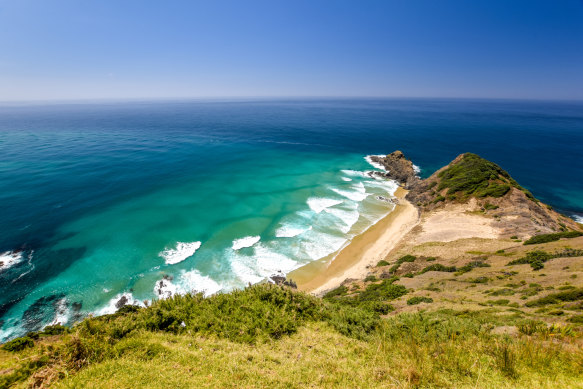
Lofty lighthouse views.Credit: iStock
From up here we can see patrons crowding the Mangonui Fish Shop, famous for its catch: blue cod, green-lipped mussels, tarakihi. My stomach pangs; part of me regrets not coming by road. But drama is afoot from this perspective – mountains accumulating on the western horizon, valleys swelling with native vegetation, the interminable 90 Mile Beach heralding our arrival at Cape Reinga.
The Pacific Ocean and the Tasman Sea, which collide at the cape and are visible on either side of the promontory, disappear as Burger descends towards “Waitiki Aerodrome”, a landing strip scratched from a paddock. Here, pilot becomes a driver-guide as we pile into a van and take the final stretch of road to Cape Reinga Lighthouse, balanced perilously on the mainland’s northernmost tip – though technically, this cardinal proclamation is false.
“They lied to us – it’s over there,” Burger says, pointing towards a salt-sprayed headland 30 kilometres to the east. “North Cape sticks out a further four nautical miles north than this point here, but for all intents and purposes this is the north of New Zealand because of the two seas meeting.”
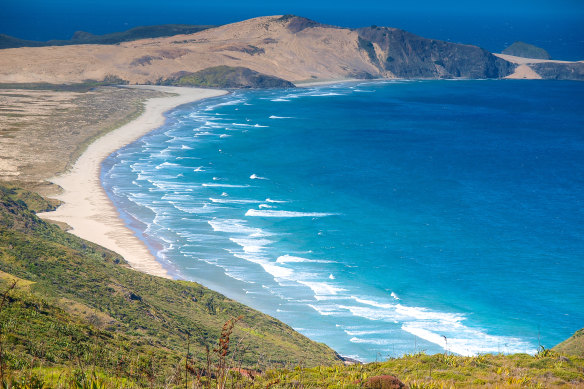
View from the top… 50 Mile Beach.Credit: iStock
Such pedantry is secondary to the cultural significance of Te Rerenga Wairua, as Cape Reinga is known by Maori. Below the lighthouse, a sacred pohutukawa tree, Te Aroha, clings to an outcrop on the lip of Piwhane (Spirits Bay).
“This place holds a lot of spiritual significance for the Maori,” Burger says. “They believe that when a person dies, their spirit travels up the country to this point here, they spend a night down in a cave. From there they climb down the root of the tree into the sea and go off to a group of islands – which we can’t see today because of the haze – the Three Kings Islands. They climb to the top of the highest point there, say their final farewells, and go off to a place called Hawaiki.”
This otherworld unlocks the Maori origin story: Hawaiki is from whence the people came, and to which they believe they’ll return one day. The stooped, sea-battered tree – 800 years old at least – has carried all the souls of departed Maori, and has borne witness to the arrival of Europeans: first Abel Tasman, a mere passer-by; and later captains James Cook and Jean-Francois de Surville, who came ashore.
Northland looks different on the flight back to Kerikeri, a topography not merely tamed into farmland and bayside settlements, but undergirded by eons of history. So untarnished are the silica dunes safeguarding Parengarenga Harbour, for a moment I think it’s snowing; so insouciant is the town of Russell (Kororareka), it’s impossible to picture its streets thronged with the country’s first European settlers, its seafront clogged with 19th century ships. The clouds have cleared now, and the town shimmers across the bay from another historic site: the grounds where New Zealand’s founding document, Te Tiriti o Waitangi (the Treaty of Waitangi), was signed in 1840.
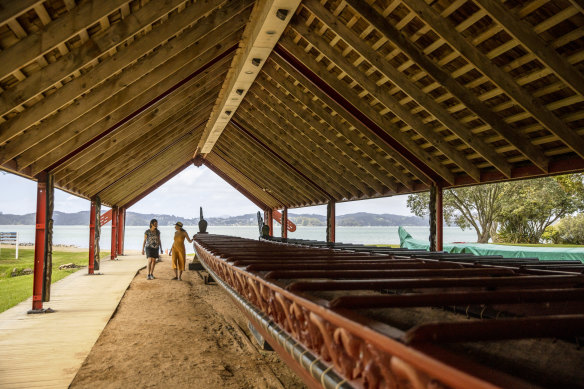
Waitangi Treaty Grounds... one of New Zealand’s most important historic sites.Credit: Camilla Rutherford/Tourism New Zealand
Back on terra firma, at Waitangi Treaty Grounds, guide Heemi Kare points across to the promontory I’ve just viewed from above. It was here that Pakeha cemented relations with his Maori ancestors.
“Can you imagine that town Russell in 1835, being the biggest whaling port in the southern hemisphere?” he says. “Can you imagine a thousand ships coming to the Bay of Islands every month for the trade? Russell was making the equivalent of $20 million dollars in today’s money back in those days.”
The mental image is compelling: ocean-wearied sailors offloading clothing, blankets, muskets; Maori stacking the wharf with their own valuable commodities – oil from seals and whales, harakeke (flax) for the weaving of ropes, kauri with which Europeans would build new masts for their weather-beaten ships.
“Russell was considered the Kingdom of Hell,” Kare says. “James Busby was sent [as British Resident in New Zealand] in 1833. That man had to implement law when no such thing as law existed in this country.”
Here at the treaty grounds, the weatherboard house Busby lived in with his family is framed by pohutukawa and the Norfolk pine he planted. Inscribed on a wall inside are words from a speech he made in 1835: “It is my wish, when I have erected my house, that all the Chiefs shall visit me, and be my friends,” it reads.
This conciliatory approach culminated in the treaty, which included provisions for the protection of Maori rights. And though the New Zealand government recently announced plans to review the document, its spirit prevails in the stories irrevocably encoded in the landscape.
“Maori identified as being tangata whenua – people of the land [and] kaitiaki, as in guardians of that land. Nobody owned the land – it belonged to the tribe,” says Maori man Michael Venner. “It was important [for Britain] because this is where the good climate was, this is where the good weather was, and this is where the power base of many of the Maori tribes existed. They also recognised it as potentially a second Britain, a second England – this place is green.”
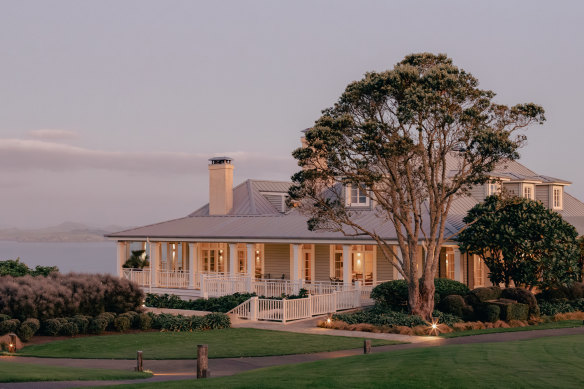
Hospitality with a side of history... Rosewood Kauri Cliffs.Credit: Rosewood Hotels
These greens billow like a skirt around Rosewood Kauri Cliffs, the resort (complete with golf course) where Venner works as guest relations manager. Beyond the cliff spans Takou Bay, lit turquoise through a chink in the storm clouds, and the Cavalli Islands, where Cook traded fish with the Maori. A road winds down from here towards Pink Beach, a private cove which had appeared, on my aerial excursion, as scalloped piping on a swathe of emerald velvet.
“This area in front of us, just to your left as we drop down, is where people existed for hundreds of years, and every summer they would come here. They called it a kaenga, which is a village,” Venner says.
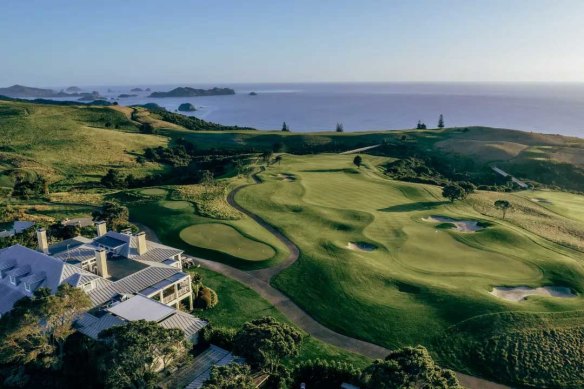
Tee off at the edge of the Earth.Credit: Rosewood Hotels
“Communities that lived here used to weave nets, dry fish, smoke fish, trade inland, and fish by the moon, by the tides – they weren’t just dropping the line and hoping. Lots of their seafood gathering traditions still exist.”
We halt at the beach, blanketed in a crush of pastel pink seashells. The storm’s remnants are dissipating; the clouds part to reveal a deep blue sky.
“We had the southerly blowing up, but it’s all changed today,” Venner says. “We’ve got westerlies coming in now.”
Those westerly winds blow warm across Northland, coursing over clifftops, skating along the bay, frisking the feathers of the turiwhatu (New Zealand dotterel) doggedly constructing its nest on the hightide line.
DETAILS
Fly
Air New Zealand flies to Auckland from Sydney and Melbourne, with onward connections to Bay of Islands (Kerikeri). See airnewzealand.com.au. Car hire is available at the Bay of Islands Airport. See hertz.co.nz.
Stay
Suites at Kauri Cliffs start from $NZ2900 ($2680) and include breakfast and dinner. See rosewoodhotels.com.
Visit
Salt Air’s half-day Cape Reinga tour costs $NZ480 ($440) a person. See saltair.co.nz. Entrance to Waitangi Treaty Grounds costs $NZ60 ($56) and includes a guided tour and cultural performance. See waitangi.org.nz.
The writer was a guest of Tourism New Zealand.
Sign up for the Traveller Deals newsletter
Get exclusive travel deals delivered straight to your inbox. Sign up now.